Multi-Technique Approach for the Sustainable Characterisation and the Digital Documentation of Painted Surfaces in the Hypogeum Environment of the Priscilla Catacombs in Rome
Abstract
1. Introduction
2. Priscilla Catacombs
3. Methods
3.1. Three-Dimensional Digital Documentation
3.2. Portable Nuclear Magnetic Resonance (NMR)
3.3. Audio Frequency–Acoustic Imaging (AF–AI)
3.4. Laser-Induced Fluorescence (LIF)
LIFART
3.5. Infrared Thermography (IRT)
4. Results
4.1. Three-Dimensional Digitalisation
4.2. Portable Magnetic Resonance
4.3. Acoustic Images
4.4. LIF Results
4.5. Thermographic Survey
4.6. Preliminary Results on Data Overlapping on the 3D Model
5. Discussion
6. Conclusions
Author Contributions
Funding
Institutional Review Board Statement
Informed Consent Statement
Data Availability Statement
Acknowledgments
Conflicts of Interest
References
- Walsh, P.P.; Banerjee, A.; Murphy, E. The UN 2030 Agenda for Sustainable Development. In Partnerships and the Sustainable Development Goals Sustain; Springer: Cham, Switzerland, 2022; pp. 1–12. [Google Scholar] [CrossRef]
- Sciurpi, F. La Conoscenza del Microclima di Ambienti Storici da Recuperare: Il Caso Della Cappella di Santa Verdiana Nell’omonimo Complesso Universitario di Firenze. October 2017. Available online: https://www.researchgate.net/publication/324057404_LA_CONOSCENZA_DEL_MICROCLIMA_DI_AMBIENTI_STORICI_DA_RECUPERARE_IL_CASO_DELLA_CAPPELLA_DI_SANTA_VERDIANA_NELL’OMONIMO_COMPLESSO_UNIVERSITARIO_DI_FIRENZE (accessed on 7 May 2024).
- Camuffo, D. Humidity and Deterioration Mechanisms. In Microclimate for Cultural Heritage, 3rd ed.; Elsevier: Amsterdam, The Netherlands, 2019; Chapter 6; pp. 93–123. ISBN 978-0-444-64106-9. [Google Scholar]
- Capitani, D.; Proietti, N.; Gobbino, M.; Soroldoni, L.; Casellato, U.; Valentini, M.; Rosina, E. An integrated study for mapping the moisture distribution in an ancient damaged wall painting. Anal. Bioanal. Chem. 2009, 395, 2245–2253. [Google Scholar] [CrossRef] [PubMed]
- Proietti, N.; Calicchia, P.; Colao, F.; De Simone, S.; Di Tullio, V.; Luvidi, L.; Prestileo, F.; Romani, M.; Tatì, A. Moisture damage in ancient masonry: A multidisciplinary approach for in situ diagnostics. Minerals 2021, 11, 406. [Google Scholar] [CrossRef]
- Calicchia, P.; De Simone, S.; Di Marcoberardino, L.; Verardi, P. Exploring the potential of a frequency resolved acoustic imaging technique in panel painting diagnostics. Measurement 2018, 118, 320–329. [Google Scholar] [CrossRef]
- Calicchia, P.; De Simone, S.; Privitera, S. Validation of Contactless Vibro-Acoustic Imaging for the Detection of Glaze Delamination in Glaze Ceramic Tiles. In Proceedings of the GlazeArt 2018, Lisabon, Portugal, 29–30 October 2018; pp. 208–226. [Google Scholar]
- Guarneri, M.; Ceccarelli, S.; Francucci, M.; Ferri De Collibus, M.; Ciaffi, M.; Gusella, V.; Liberotti, R.; La Torre, M. Multi-Sensor Analysis for Experimental Diagnostic and Monitoring Techniques at San Bevignate Templar Church in Perugia. Int. Arch. Photogramm. Remote Sens. Spat. Inf. Sci. 2023, 48, 693–700. [Google Scholar] [CrossRef]
- Di Tuccio, M.C.; Ludwig, N.; Gargano, M.; Bernardi, A. Thermographic inspection of cracks in the mixed materials statue: Ratto delle Sabine. Herit. Sci. 2015, 3, 10. [Google Scholar] [CrossRef]
- Caneve, L.; Guarneri, M.; Lai, A.; Spizzichino, V.; Ceccarelli, S.; Mazzei, B. Non-Destructive laser based techniques for biodegradation analysis in cultural heritage. NDT E Int. 2019, 104, 108–113. [Google Scholar] [CrossRef]
- Guarneri, M.; Ceccarelli, S.; Ciaffi, M. Multi-wavelengths3D laser scanner for investigation and reconstruction of19 th century charcoal inscriptions. In Proceedings of the IMEKO International Conference on Metrology for Archaeology and Cultural Heritage, Lecce, Italy, 23–25 October 2017; pp. 161–165, ISBN 978-92-990084-0-9. [Google Scholar]
- Stylianidis, E.; Remondino, F. 3D Recording, Documentation and Management of Cultural Heritage; Whittles Publishing: Dunbeath, UK, 2016; pp. 1–13. ISBN 9781849951685. [Google Scholar]
- Ronchi, D.; Limongiello, M.; Demetrescu, E.; Ferdani, D. Multispectral UAV Data and GPR Survey for Archeological Anomaly Detection Supporting 3D Reconstruction. Sensors 2023, 23, 2769. [Google Scholar] [CrossRef]
- Farella, E.M. 3D mapping of underground environments with a hand-held laser scanner. Sez. Sci. 2016, 2, 1–10. [Google Scholar]
- Remmedia Project. 2023. Available online: https://www.enea.it/it/progetti/progetti-nazionali/progetto-remedia.html (accessed on 7 May 2024).
- Priscilla Catacombs. Available online: https://catacombepriscilla.com/ (accessed on 7 May 2024).
- Fantoni, R.; Almaviva, S.; Caneve, L.; Colao, F.; De Collibus, M.F.; De Dominicis, L.; Francucci, M.; Guarneri, M.; Lazic, V.; Palucci, A.; et al. In situ and remote laser diagnostics for material characterization from plasma facing components to Cultural Heritage surfaces. J. Instrum. 2019, 14, C07004. [Google Scholar] [CrossRef]
- Ceccarelli, S.; Guarneri, M.; Fantoni, R.; Giacopini, L.; Danielis, A.; Ferri De Collibus, M.; Ciaffi, M.; Fornetti, G.; Francucci, M. Colorimetric Study on Optical Data from 3D Laser Scanner Prototype for Cultural Heritage Applications. In New Activities For Cultural Heritage; Ceccarelli, M., Cigola, M., Eds.; Springer International Publishing: Berlin/Heidelberg, Germany, 2017; pp. 190–199. ISBN 978-3-319-67025-6. [Google Scholar]
- Ceccarelli, S.; Guarneri, M.; Ferri de Collibus, M.; Francucci, M.; Ciaffi, M.; Danielis, A. Laser Scanners for High-Quality 3D and IR Imaging in Cultural Heritage Monitoring and Documentation. J. Imaging 2018, 4, 130. [Google Scholar] [CrossRef]
- Guarneri, M.; De Collibus, M.F.; Francucci, M.; Ciaffi, M. The Importance of Artworks 3D Digitalization at the Time of COVID Epidemy: Case Studies by the Use of a Multi-wavelengths Technique. In Proceedings of the 2020 IEEE 5th International Conference on Image, Vision and Computing (ICIVC), Beijing, China, 10–12 July 2020; pp. 113–117. [Google Scholar]
- Ferri De Collibus, M.; Fornetti, G.; Guarneri, M.; Paglia, E.; Poggi, C.; Ricci, R. ITR: An AM Laser Range Finding System for 3D Imaging and Multi-Sensor Data Integration. In Proceedings of the 1st International Conference on Sensing Technology, Palmerston North, New Zealand, 21–23 November 2005; pp. 641–646. [Google Scholar]
- Mullen, L.; Laux, A.; Concannon, B.; Zege, E.P.; Katsev, I.L.; Prikhach, A.S. Amplitude-modulated laser imager. Appl. Opt. 2004, 43, 3874–3892. [Google Scholar] [CrossRef] [PubMed]
- Systems Standford Research About Lock-In Amplifiers. Appl. Note 2011, 1–9. Available online: https://www.thinksrs.com/downloads/pdfs/applicationnotes/AboutLIAs.pdf (accessed on 7 May 2024).
- McCann, J.J.; Vonikakis, V.; Rizzi, A. HDR Scene Capture and Appearance; SPIE: Bellingham, WA, USA, 2017; ISBN 9781510618534. [Google Scholar]
- Proietti, N.; Capitani, D.; Cozzolino, S.; Valentini, M.; Pedemonte, E.; Princi, E.; Vicini, S.; Segre, A.L. In Situ and Frontal Polymerization for the Consolidation of Porous Stones: A Unilateral NMR and Magnetic Resonance Imaging Study. J. Phys. Chem. B 2006, 110, 23719–23728. [Google Scholar] [CrossRef] [PubMed]
- Calicchia, P.; De Simone, S.; Verardi, P. Non destructive evaluation of glaze delaminations in glazed ceramic tiles: Laboratory tests. In Proceedings of the GlazeArch 2015 International Conference Glazed Ceramics in Architectural Heritage, Lisabon, Portugal, 2–3 July 2015; pp. 133–152. [Google Scholar]
- Calicchia, P.; De Simone, S.; Camassa, A.; Tatì, A.; Petrucci, F. Integration of Non-Destructive Acoustic Imaging Investigation with Photogrammetric and Morphological Analysis to Study the “Graecia Vetus” in the Chigi Palace of Ariccia. Heritage 2022, 5, 3762–3784. [Google Scholar] [CrossRef]
- Gómez-Morón, A.; Ortiz, R.; Colao, F.; Fantoni, R.; Becerra, J.; Ortiz, P. Laser-Induced Fluorescence mapping of pigments in a secco painted murals. Ge-Conserv 2020, 17, 233–250. [Google Scholar] [CrossRef]
- Romani, M.; Capobianco, G.; Pronti, L.; Colao, F.; Seccaroni, C.; Puiu, A.; Felici, A.C.; Verona-Rinati, G.; Cestelli-Guidi, M.; Tognacci, A.; et al. Analytical chemistry approach in cultural heritage: The case of Vincenzo Pasqualoni’s wall paintings in S. Nicola in Carcere (Rome). Microchem. J. 2020, 156, 104920. [Google Scholar] [CrossRef]
- Romani, A.; Miliani, C.; Clementi, C.; Grazia, C.; Colao, F.; Fantoni, R.; Valentini, G.; Detalle, V.; Bai, X. Portable Instrumentation. In Springer Series on Fluorescence; Springer International Publishing: Cham, Switzerland, 2023; pp. 1–34. [Google Scholar]
- Gómez-Morón, M.A.; Ortiz, R.; Colao, F.; Fantoni, R.; Gómez-Villa, J.L.; Becerra, J.; Ortiz, P. Monitoring the Restoration of a Seventeenth-Century Wooden Artwork Using Laser-Induced Fluorescence and Digital Image Analysis. Appl. Spectrosc. 2021, 75, 70–80. [Google Scholar] [CrossRef]
- Gaussorgues, G. Infrared Thermography; Springer: Dordrecht, The Netherlands, 1994; ISBN 978-94-010-4306-9. [Google Scholar]
- Dritsa, V.; Orazi, N.; Yao, Y.; Paoloni, S.; Koui, M.; Sfarra, S. Thermographic Imaging in Cultural Heritage: A Short Review. Sensors 2022, 22, 9076. [Google Scholar] [CrossRef]
- Theodorakeas, P.; Cheilakou, E.; Ftikou, E.; Koui, M. Passive and active infrared thermography: An overview of applications for the inspection of mosaic structures. J. Phys. Conf. Ser. 2015, 655, 012061. [Google Scholar]
- Pucci, M.; Cicero, C.; Orazi, N.; Mercuri, F.; Zammit, U.; Paoloni, S.; Marinelli, M. Active infrared thermography applied to the study of a painting on paper representing the Chigi’s family tree. Stud. Conserv. 2015, 60, 88–96. [Google Scholar] [CrossRef]
- Ambrosini, D.; Daffara, C.; Di Biase, R.; Paoletti, D.; Pezzati, L.; Bellucci, R.; Bettini, F. Integrated reflectography and thermography for wooden paintings diagnostics. J. Cult. Herit. 2010, 11, 196–204. [Google Scholar] [CrossRef]
- Mercuri, F.; Ceccarelli, S.; Orazi, N.; Cicero, C.; Paoloni, S.; Felici, A.C.; Matera, F.; Nuzzo, M.; Zammit, U. Combined use of infrared imaging techniques for the study of underlying features in the Santa Maria in Cosmedin altarpiece. Archaeometry 2021, 63, 1009–1023. [Google Scholar] [CrossRef]
- Daffara, C.; Parisotto, S.; Ambrosini, D. Multipurpose, dual-mode imaging in the 3–5 µm range (MWIR) for artwork diagnostics: A systematic approach. Opt. Lasers Eng. 2018, 104, 266–273. [Google Scholar] [CrossRef]
- Maldague, X.; Galmiche, F.; Ziadi, A. Advances in Pulsed Phase Tomography. Infrared Phys. Technol. 2001, 43, 175–181. [Google Scholar] [CrossRef]
- Wu, D.; Busse, G. Lock-in thermography for nondestructive evaluation of materials. Rev. Générale Therm. 1998, 37, 693–703. [Google Scholar] [CrossRef]
- Gleiter, A.; Riegert, G.; Zweschper, T.; Busse, G. Ultrasound lock-in thermography for advanced depth resolved defect selective imaging. Insight Non-Destr. Test. Cond. Monit. 2007, 49, 272–274. [Google Scholar] [CrossRef]
- D’accardi, E.; Palumbo, D.; Galietti, U. A comparison among different ways to investigate composite materials with lock-in thermography: The multi-frequency approach. Materials 2021, 14, 2525. [Google Scholar] [CrossRef]
- Zhu, P.; Wu, D.; Wang, Y.; Miao, Z. Defect detectability based on square wave lock-in thermography. Appl. Opt. 2022, 61, 6134–6143. [Google Scholar] [CrossRef]
- Mattana, S.; Fovo, A.D.; Lagarto, J.L.; Bossuto, M.C.; Shcheslavskiy, V.; Fontana, R.; Cicchi, R. Automated Phasor Segmentation of Fluorescence Lifetime Imaging Data for Discriminating Pigments and Binders Used in Artworks. Molecules 2022, 27, 1475. [Google Scholar] [CrossRef]
- Marinelli, M.; Pasqualucci, A.; Romani, M.; Verona-Rinati, G. Time resolved laser induced fluorescence for characterization of binders in contemporary artworks. J. Cult. Herit. 2017, 23, 98–105. [Google Scholar] [CrossRef]
- Spizzichino, V.; Bertani, L.; Caneve, L.; Caso, M.F. Rapid analysis of marble treatments by laser induced fluorescence. Opt. Quantum Electron. 2020, 52, 117. [Google Scholar] [CrossRef]
- Cignoni, P.; Callieri, M.; Corsini, M.; Dellepiane, M.; Ganovelli, F.; Ranzuglia, G. MeshLab: An open-source mesh processing tool. In Eurographics Italian Chapter Conference; The Eurographics Association: Eindhoven, The Netherlands, 2008; pp. 129–136. [Google Scholar]

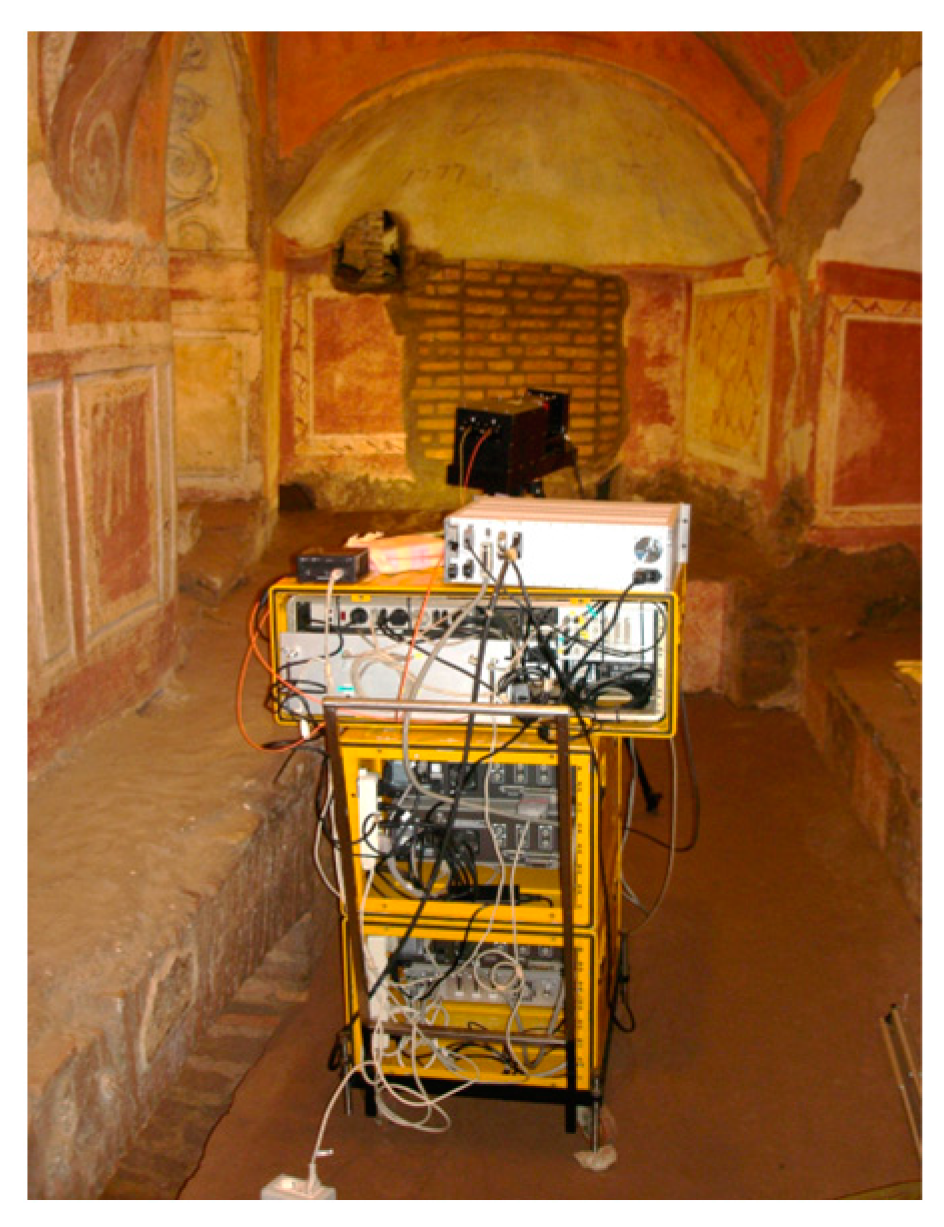

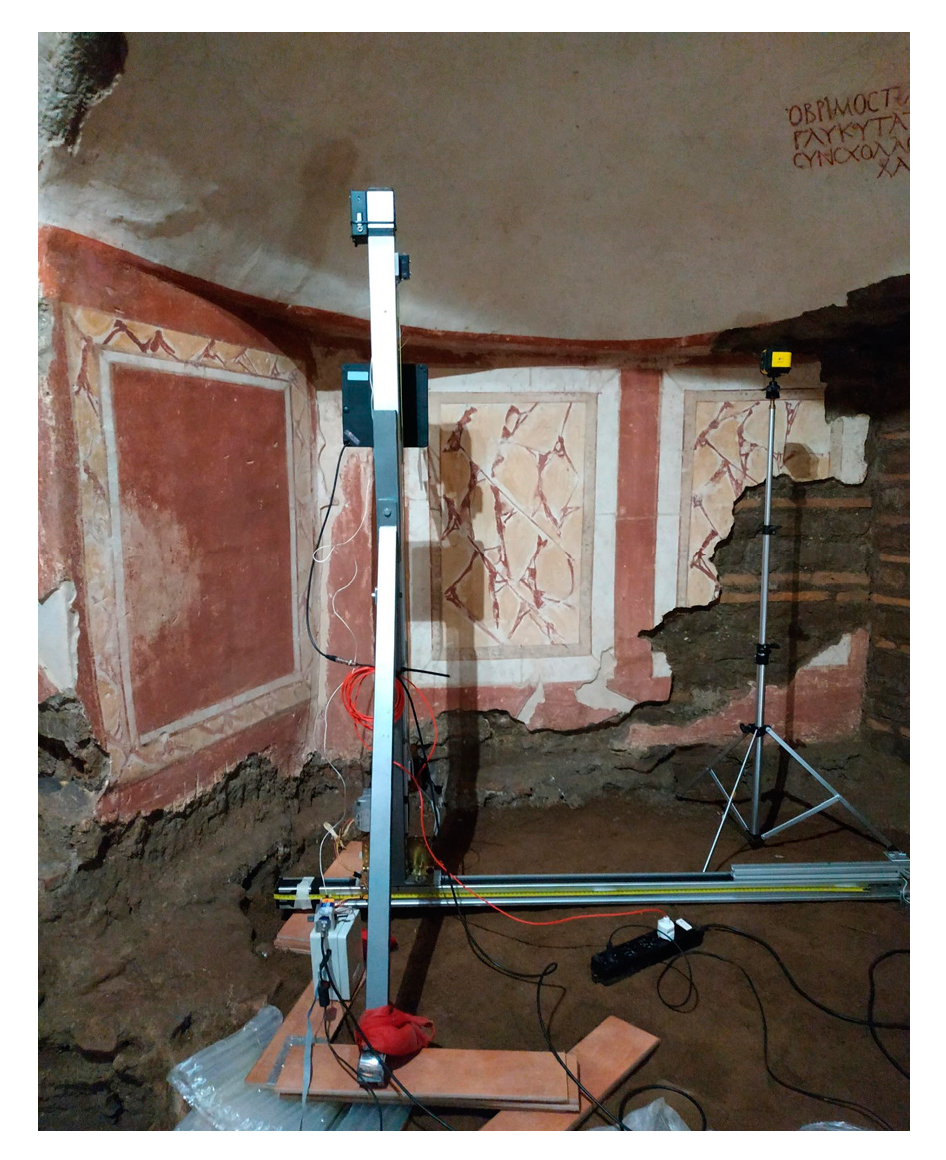
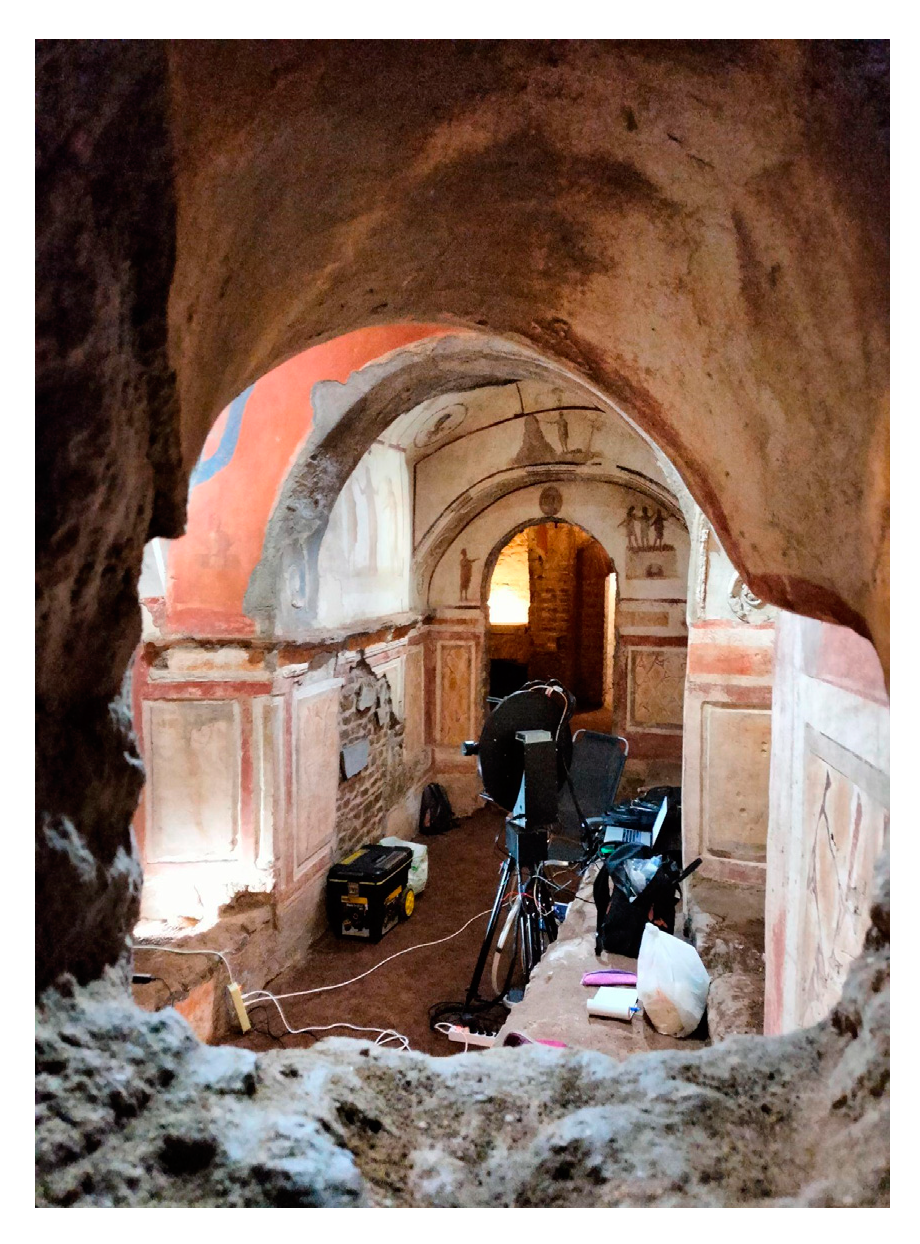

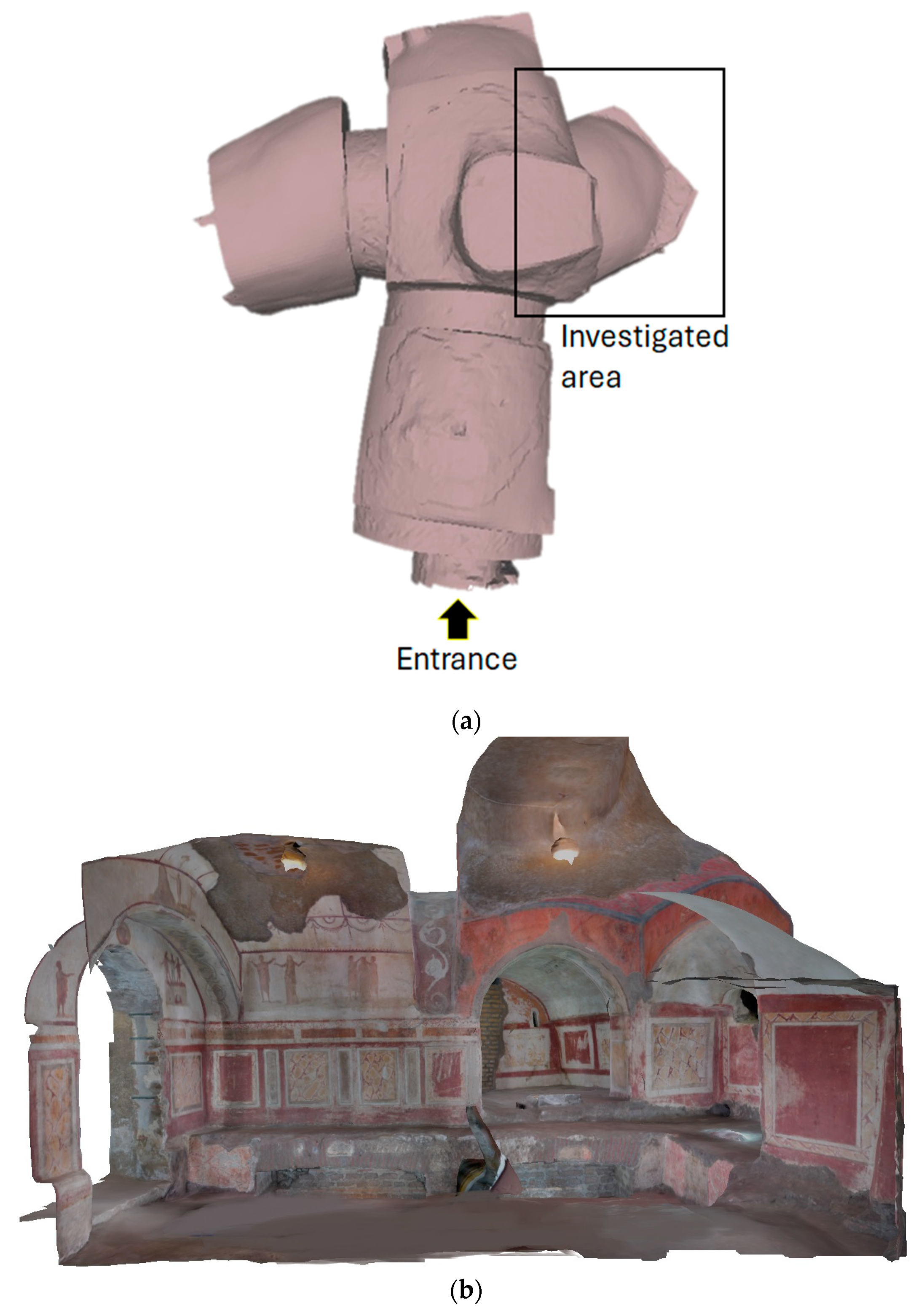


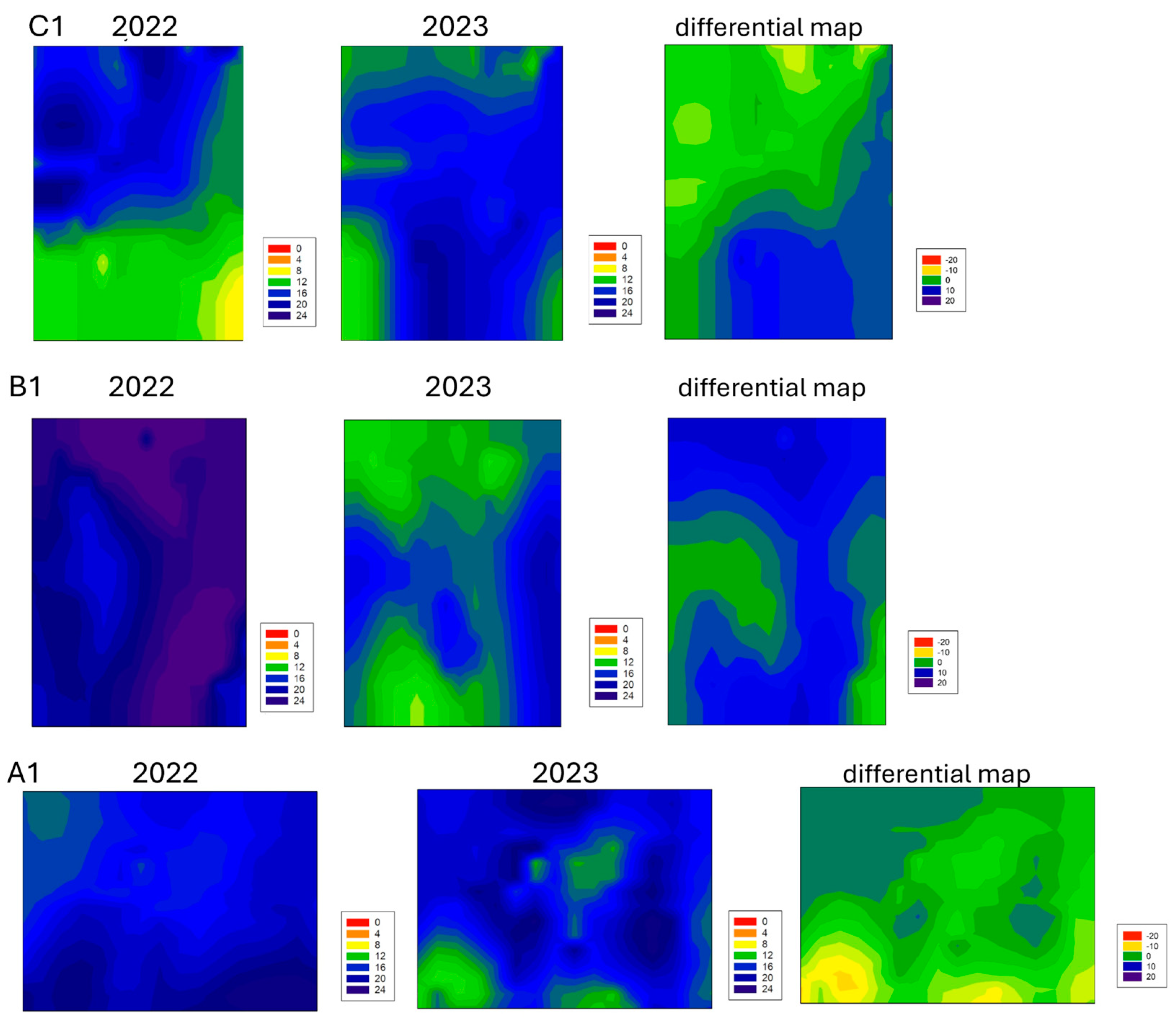


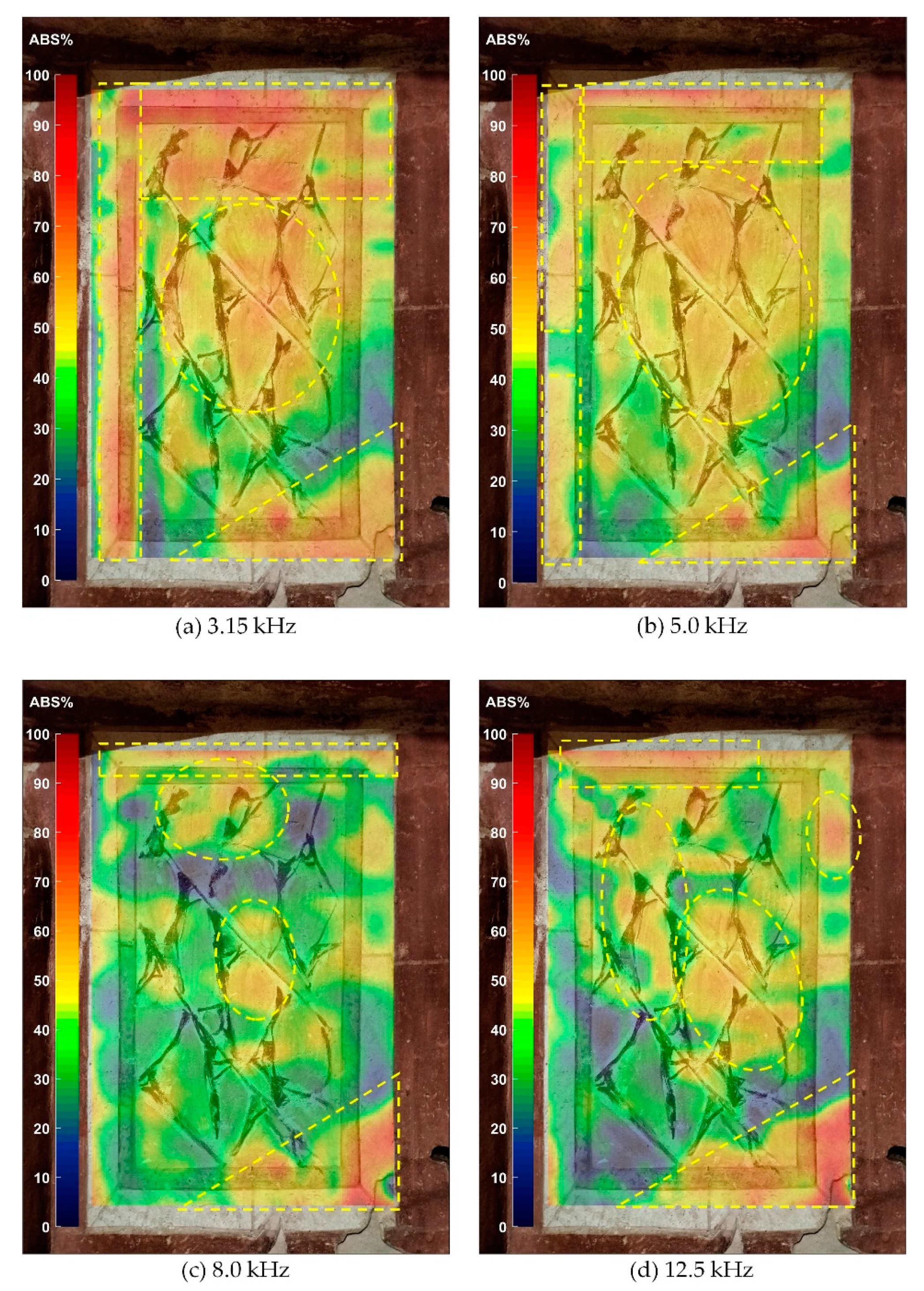
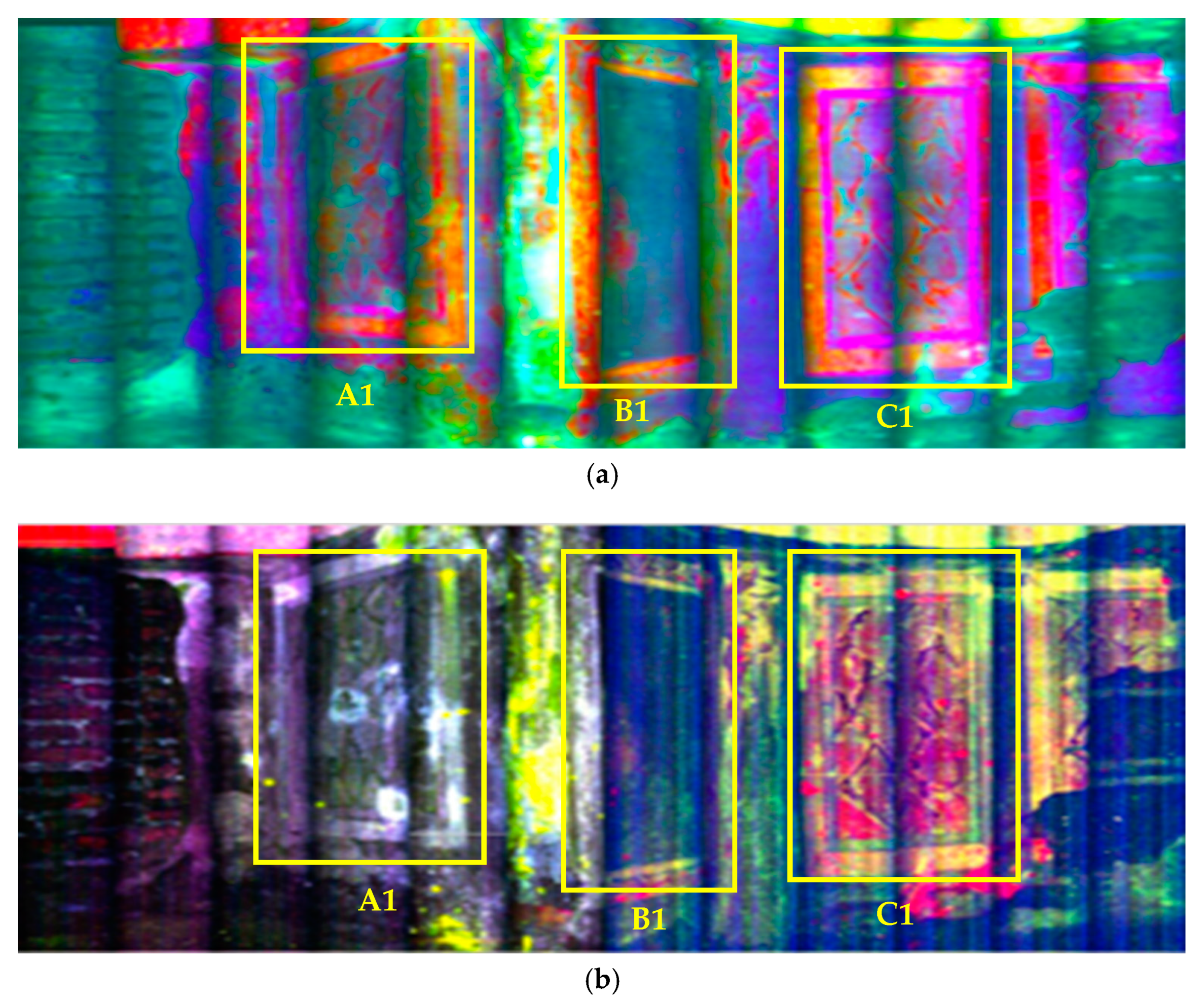

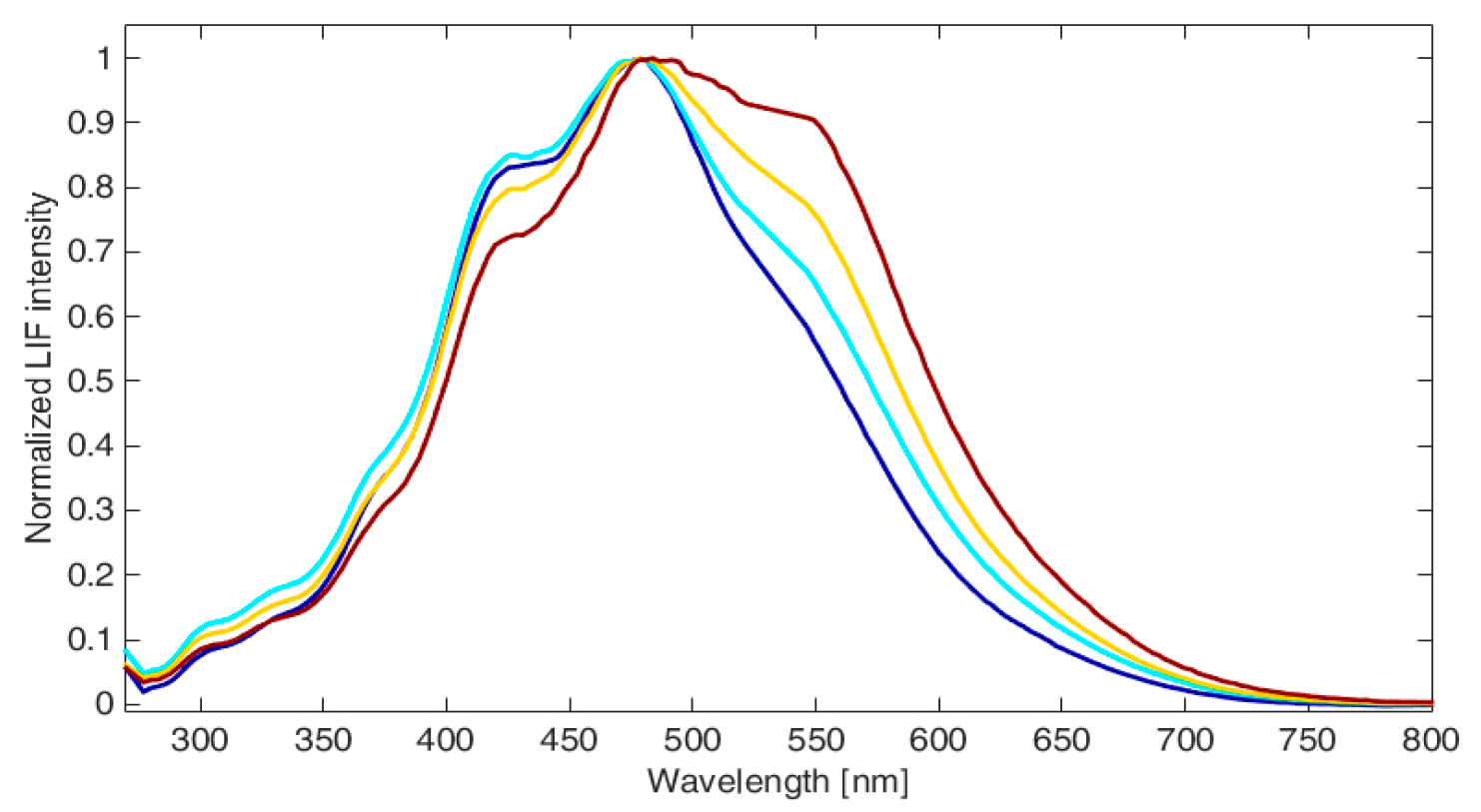



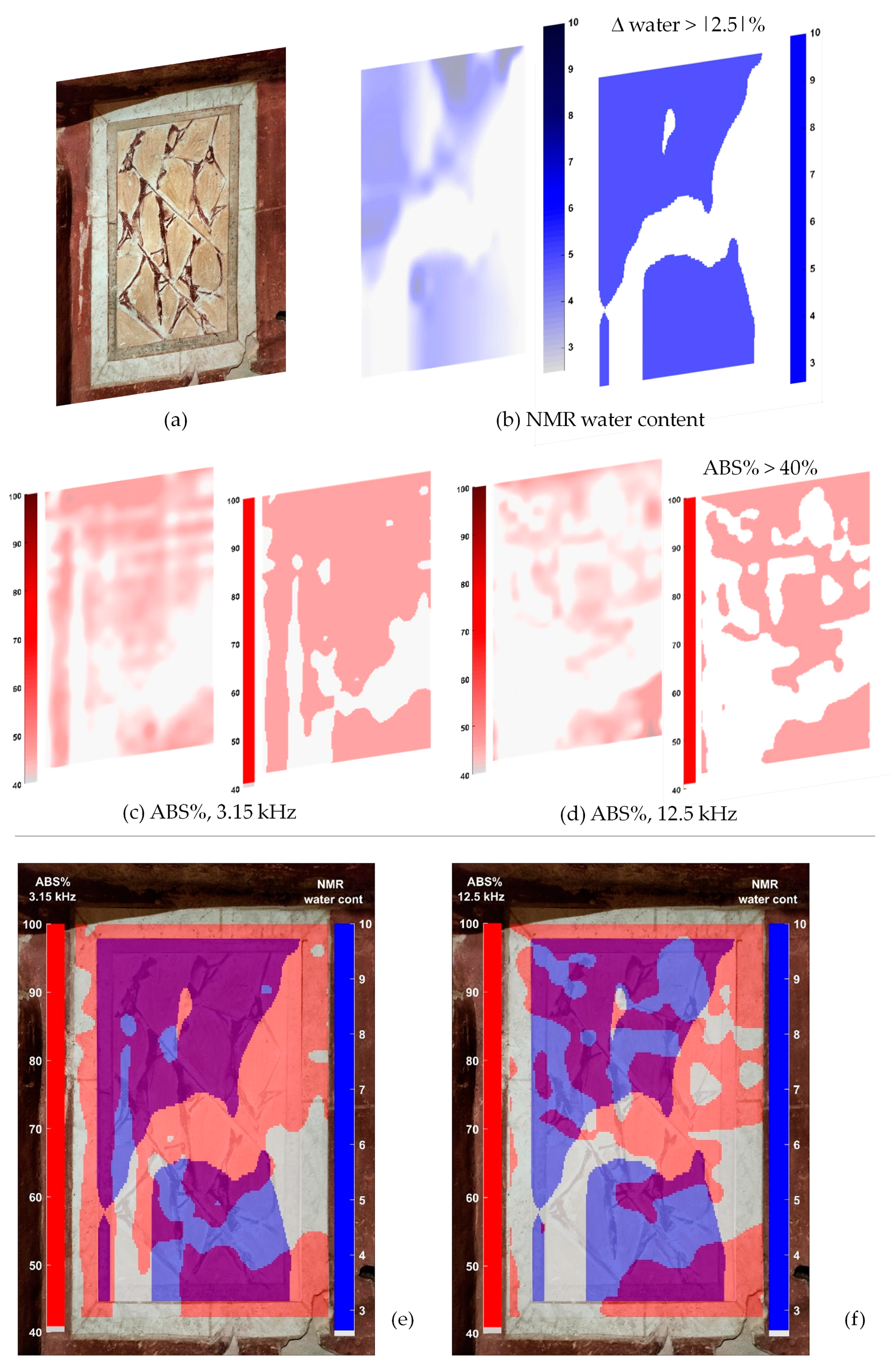


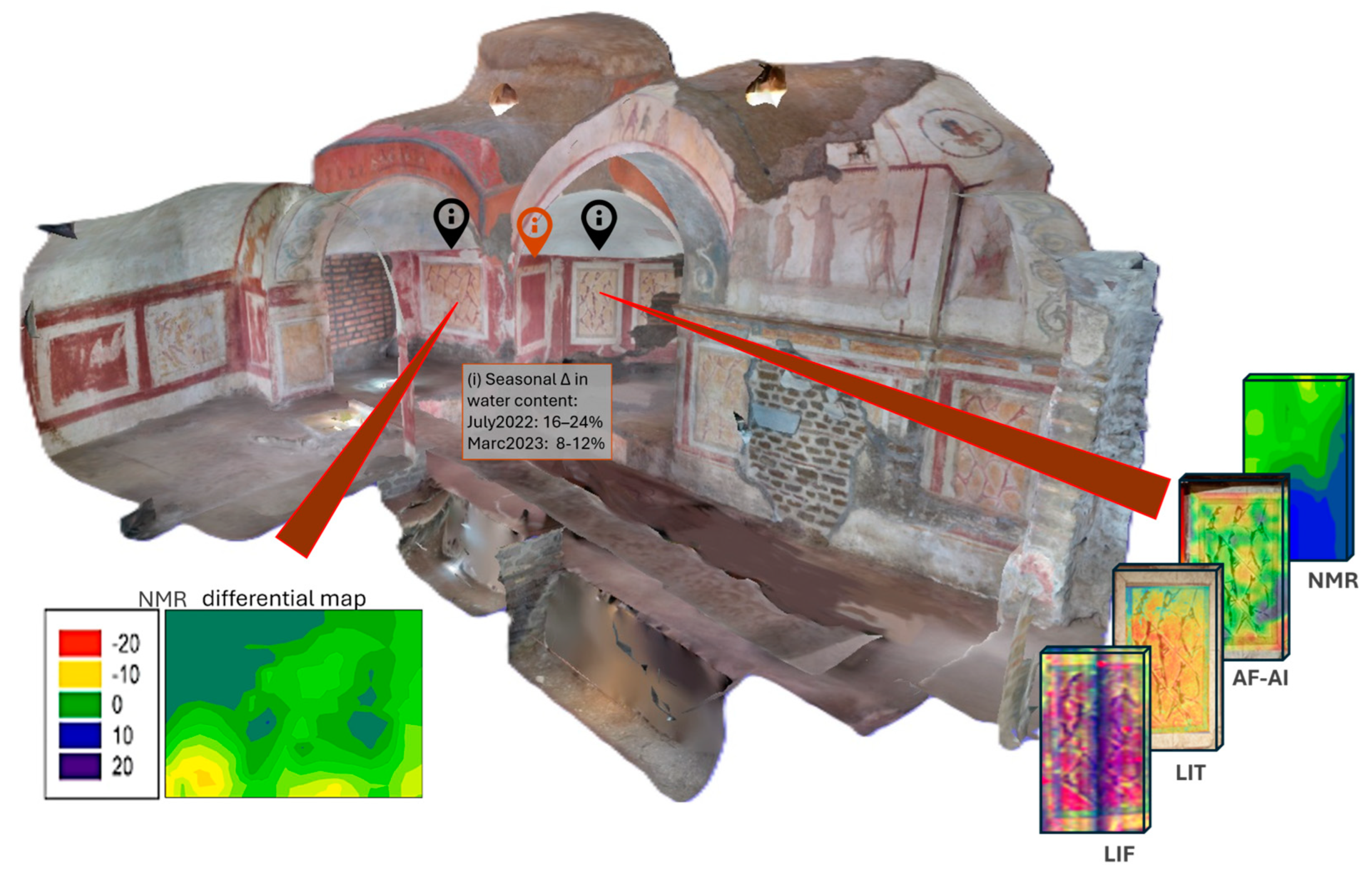
Disclaimer/Publisher’s Note: The statements, opinions and data contained in all publications are solely those of the individual author(s) and contributor(s) and not of MDPI and/or the editor(s). MDPI and/or the editor(s) disclaim responsibility for any injury to people or property resulting from any ideas, methods, instructions or products referred to in the content. |
© 2024 by the authors. Licensee MDPI, Basel, Switzerland. This article is an open access article distributed under the terms and conditions of the Creative Commons Attribution (CC BY) license (https://creativecommons.org/licenses/by/4.0/).
Share and Cite
Calicchia, P.; Ceccarelli, S.; Colao, F.; D’Erme, C.; Di Tullio, V.; Guarneri, M.; Luvidi, L.; Proietti, N.; Spizzichino, V.; Zampelli, M.; et al. Multi-Technique Approach for the Sustainable Characterisation and the Digital Documentation of Painted Surfaces in the Hypogeum Environment of the Priscilla Catacombs in Rome. Sustainability 2024, 16, 8284. https://doi.org/10.3390/su16198284
Calicchia P, Ceccarelli S, Colao F, D’Erme C, Di Tullio V, Guarneri M, Luvidi L, Proietti N, Spizzichino V, Zampelli M, et al. Multi-Technique Approach for the Sustainable Characterisation and the Digital Documentation of Painted Surfaces in the Hypogeum Environment of the Priscilla Catacombs in Rome. Sustainability. 2024; 16(19):8284. https://doi.org/10.3390/su16198284
Chicago/Turabian StyleCalicchia, Paola, Sofia Ceccarelli, Francesco Colao, Chiara D’Erme, Valeria Di Tullio, Massimiliano Guarneri, Loredana Luvidi, Noemi Proietti, Valeria Spizzichino, Margherita Zampelli, and et al. 2024. "Multi-Technique Approach for the Sustainable Characterisation and the Digital Documentation of Painted Surfaces in the Hypogeum Environment of the Priscilla Catacombs in Rome" Sustainability 16, no. 19: 8284. https://doi.org/10.3390/su16198284
APA StyleCalicchia, P., Ceccarelli, S., Colao, F., D’Erme, C., Di Tullio, V., Guarneri, M., Luvidi, L., Proietti, N., Spizzichino, V., Zampelli, M., & Zito, R. (2024). Multi-Technique Approach for the Sustainable Characterisation and the Digital Documentation of Painted Surfaces in the Hypogeum Environment of the Priscilla Catacombs in Rome. Sustainability, 16(19), 8284. https://doi.org/10.3390/su16198284









